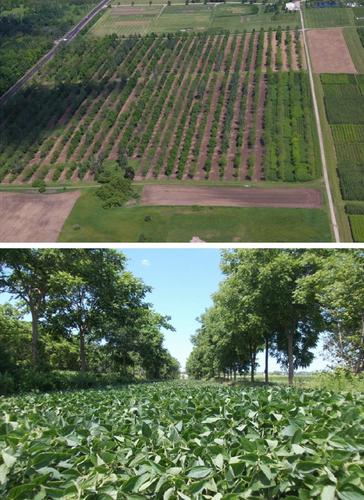Agroforestry Systems ( IF 2.2 ) Pub Date : 2024-01-22 , DOI: 10.1007/s10457-023-00942-z Amir Behzad Bazrgar , Naresh Thevathasan , Andrew Gordon , Jamie Simpson

|
Allometric equations were developed for estimating aboveground biomass carbon (AGBC) in five tree species grown in a tree-based intercropping system at the University of Guelph Agroforestry Research Station, Guelph, Ontario, Canada. A total of 66 representative trees from five species: red oak (Quercus rubra) [n = 12], black walnut (Juglans nigra) [n = 16], black locust (Robinia pseudoacacia) [n = 10], white ash (Fraxinus americana) [n = 15], Norway spruce (Picea abies) [n = 13] were selected, harvested and their aboveground biomass and carbon content were quantified. Three commonly used allometric models were used to develop predictive equations. Regression models were developed and parameterized for each tree species and the best are presented based on information criteria (AIC, AICc, and BIC), mean absolute percentage error (MAPE), over/under estimation (MOUE), root mean square error (RMSE), R2, and regression coefficients (a, b) of the observed/predicted (OP) linear regression analysis. All equations with diameter at breast height (D) only and D and tree height (H) as the predictor variables fitted the AGBC data well, with R2 > 97% and RMSE < 40. However, a power model using D as the only predictor is recommended as the best model for black walnut, black locust, white ash, and Norway spruce. The models presented are the best fitted allometric equations for the indicated species and are recommended for these species, growing on similar soils under the same temperate conditions at densities of < 125 tree per hectare.
中文翻译:

用于估算加拿大安大略省南部间作农林业系统中种植的五种树种的地上生物量碳的异速生长方程
加拿大安大略省圭尔夫市圭尔夫大学农林研究站开发了异速生长方程,用于估算在树基间作系统中种植的五种树种的地上生物量碳(AGBC)。共有 66 棵代表树,来自 5 个物种:红橡 ( Quercus rubra ) [n = 12]、黑胡桃 ( Juglans nigra ) [n = 16]、黑刺槐 ( Robinia pseudoacacia ) [n = 10]、白蜡树 ( Fraxinus)选择、收获美洲云杉 (Picea abies) [n = 15]、挪威云杉 ( Picea abies ) [n = 13],并对其地上生物量和碳含量进行量化。使用三种常用的异速生长模型来开发预测方程。针对每个树种开发并参数化回归模型,并根据信息标准(AIC、AICc 和 BIC)、平均绝对百分比误差 (MAPE)、高估/低估 (MOUE)、均方根误差 (RMSE) 呈现最佳模型)、R 2以及观察/预测 (OP) 线性回归分析的回归系数 (a, b)。所有仅以胸径 (D) 和 D 和树高 (H) 作为预测变量的方程都很好地拟合了 AGBC 数据,R 2 > 97% 且 RMSE < 40。然而,仅使用 D 的功效模型推荐预测器作为黑胡桃木、黑刺槐、白蜡木和挪威云杉的最佳模型。所提出的模型是针对指定物种的最佳拟合异速生长方程,并推荐用于这些物种,这些物种在相同的温带条件下在相似的土壤上生长,密度为每公顷 < 125 棵树。



























 京公网安备 11010802027423号
京公网安备 11010802027423号